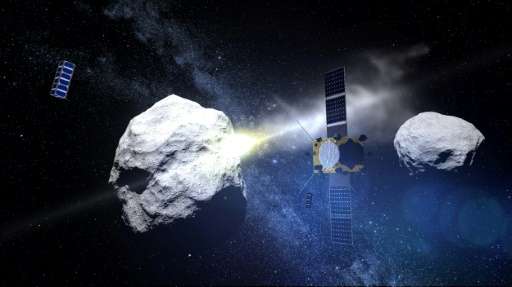Cash crunch for anti-Armageddon asteroid mission

A mission to smash a spacecraft into an asteroid moon to alter its trajectory, a possible dry-run for an exercise in saving the Earth from Armageddon, has run into a cash crunch.
The proposed joint European-US mission, which sounds like it could form the plot for a sci-fi Hollywood blockbuster, has been dubbed AIDA (Asteroid Impact & Deflection Assessment).
In 2022, the idea is to launch a 600-kilogramme (1,300-pound) NASA spacecraft at Didymos, an asteroid some 13 million kilometres (eight million miles) from Earth, after a two-year self-guided journey through space.
The craft will crash into the 800 metre-wide Didymos' tiny satellite, Didymoon, at a speed of about six kilometres (3.7 miles) per second.
The aim would be to "redirect" the 160-metre moon—the first time humans would have altered the course of a Solar System body.
For the European part of the futuristic project, a small craft dubbed AIM (Asteroid Impact Mission), will move in close to the action, observing the crash up close and analysing its impact on the moon's structure and orbit.
AIM will be fitted with a camera to capture images of the impact, which is likely to leave a large crater on Didymoon and unleash a massive cloud of debris.
"The goal is to test the technology so that if an asteroid threatens our planet one day, we will have the capability of changing its trajectory," Ian Carnelli, AIM project head at the European Space Agency (ESA), told AFP.
The mission suffered a major setback, however, when European space ministers gathered in Switzerland in December for a regular policy and budget meeting, rejected funding for AIM.
The ESA had sought 250 million euros ($269 million).
Not giving up
ESA director general Jan Woerner says he remains hopeful and stressed "the mission was not cancelled."
"We are still working on it and I am not giving up," he told journalists in Paris last week. "The member states, the ministers, asked me not to give up."
Design of the AIM craft was on track, said Woerner, but several cost-cutting options were being considered—including reducing the number of scientific instruments on board.
"By doing this, the budget may be lowered to about 150 million euros, launch excluded," AIM scientific head Patrick Michel told AFP.
The original design for AIM includes a camera, radio equipment, a tiny lander, mini-satellites and radar instruments.
For AIM, the clock is ticking.
Project development contracts with European companies come up for renewal soon.
"We have about two months left to... find the money," Carnelli said.
The $150-million mission can go ahead with or without Europe. Either way, the deep space collision will be observed with instruments on Earth.
Scientists believe more than 1,700 asteroids are on trajectories that may pose a collision danger to Earth.
"We have to keep an eye on them," said Michel. While strikes by large asteroids are rare, the fallout can be dire.
"If an asteroid of 150 metres falls on Earth, it will be like 10,000 Hiroshima (atomic) bombs in terms of energy released."
In 2013, an asteroid exploded in a blinding fireball over Russia, sending debris plummeting to Earth.
The shockwave exploded windows, injuring some 1,600 people, and a burst of ultraviolet light left more than two dozen people with skin burns.
The December meeting in Lucerne ended a long period of uncertainty for two key European projects—the ExoMars mission to place a life-seeking rover on the Red Planet, and maintaining a presence on the International Space Station.
Last October, a 230-million-euro test lander, designed to lay the groundwork for the planned rover, smashed into Mars, prompting the ESA to seek additional cash to keep the project alive.
© 2017 AFP





















